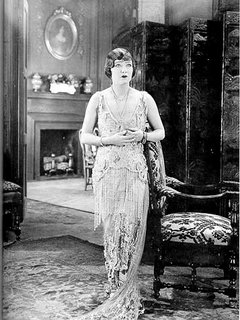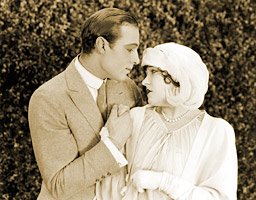 Beyond the Rocks (1922)
Beyond the Rocks (1922)
Director: Sam Wood
Major news was made in the film world in 2004 when Nederlands Filmmuseum announced that a complete print of the Dutch version of Beyond the Rocks (six reels instead of the seven-reel American version) was found among the effects of a private Dutch film collector. This film, the only screen collaboration between Rudolph Valentino and Gloria Swanson, was presumed lost forever. Its rediscovery and first-rate restoration (including original tints) by Nederlands Filmmuseum is a triumph for cinematic history and scholarship, as well as an enormous treat for film buffs all over the world.
This film returned to the big screen in Chicago this weekend thanks to the efforts of the Silent Film Society of Chicago and the historic Music Box Theatre. I was one among the sizable crowd that turned out to welcome Beyond the Rocks back. Well-known silent-film organist Jay Warren accompanied the film on the Music Box's Wurlitzer pipe organ.
In Warren's introduction to the film, he said Beyond the Rocks wouldn't have won any Oscars, had they existed in 1922, and that the real draw is Swanson and Valentino. In this remark, he was exactly right. The film is a silly affair. Swanson plays the youngest of three daughters of a retired British officer (Alec Francis) struggling to make ends meet. The older daughters contrive to marry her off to a rich older man (Robert Bolder), which she does for the sake of her father's financial security. But she meets and falls in love with Lord Bracondale (Valentino). When Swanson's husband inadvertently discovers that his wife is in love with another man, he runs off on a dangerous archeological expedition in North Africa, where he is killed by Bedouin thieves. Swanson and Valentino end up together, "beyond the rocks" of their previous difficulties, sailing into a happily ever after.
This film packs in the action in a way that makes it seem as though we are watching The Perils of Pauline. Twice Valentino must come to Swanson's aid--once when she unaccountably falls overboard from her rowboat in a laugh-inducing scene and once when she falls over a cliff in the Alps and dangles precariously from a rope tied around her waist. Rescuing the damsel in distress moves Valentino from inveterate bachelor to ardent suitor.
 Swanson's wardrobe is very odd. She wears a youthful sailor suit at the beginning of the film that makes her look ridiculous. After her character's marriage, she becomes uber-glamorous. Her outfits range from bizarre to ravishing. She even dons 18th century garb, supposedly to play a part in an amateur drama at the estate of Bracondale's sister. We don't see the drama, of course, only Valentino in a courtier's costume stolen from the man who was to play opposite Swanson riding off with Swanson in a carriage loaded with play-acting footmen. Romance is the real star of this plot, and in the silent era, that meant all the bodice-ripping elegance they could muster. When the film switched to North Africa, where Swanson, Valentino, and Francis pursue Bolder to dissuade him from his suicide mission, I was sure we'd see Rudy back in his Sheik costume. This was not the case, but he certainly did look very fetching in a pith helmet and riding jodhpurs.
Swanson's wardrobe is very odd. She wears a youthful sailor suit at the beginning of the film that makes her look ridiculous. After her character's marriage, she becomes uber-glamorous. Her outfits range from bizarre to ravishing. She even dons 18th century garb, supposedly to play a part in an amateur drama at the estate of Bracondale's sister. We don't see the drama, of course, only Valentino in a courtier's costume stolen from the man who was to play opposite Swanson riding off with Swanson in a carriage loaded with play-acting footmen. Romance is the real star of this plot, and in the silent era, that meant all the bodice-ripping elegance they could muster. When the film switched to North Africa, where Swanson, Valentino, and Francis pursue Bolder to dissuade him from his suicide mission, I was sure we'd see Rudy back in his Sheik costume. This was not the case, but he certainly did look very fetching in a pith helmet and riding jodhpurs.
 The amazing, dazzling thing about Beyond the Rocks is the interaction between Valentino and Swanson. It's pure dynamite. As Stella Du Bois Kowalski said in A Streetcar Named Desire, "There are things that happen between a man and a woman in the dark that sorta make everything else seem unimportant." This is especially true for the film buff watching these two beautiful creatures from his or her seat in a darkened theatre. Their electrifying chemistry and screen presence have their equal in only a few other pairings, most notably Garbo and Gilbert. I was swooning about every five minutes at this handsome, sexy pair, and that's all I really cared about. It's hard to believe these two stars were never teamed again.
The amazing, dazzling thing about Beyond the Rocks is the interaction between Valentino and Swanson. It's pure dynamite. As Stella Du Bois Kowalski said in A Streetcar Named Desire, "There are things that happen between a man and a woman in the dark that sorta make everything else seem unimportant." This is especially true for the film buff watching these two beautiful creatures from his or her seat in a darkened theatre. Their electrifying chemistry and screen presence have their equal in only a few other pairings, most notably Garbo and Gilbert. I was swooning about every five minutes at this handsome, sexy pair, and that's all I really cared about. It's hard to believe these two stars were never teamed again.
It is very fortunate that Beyond the Rocks was liberated from the lock and key under which it has been kept for so many years by a private collector. The magic created by Swanson and Valentino, now finally revealed to the millions of film fans who have been denied it for so long, is as special as anything ever committed to celluloid. l


2 Comments:
At 12:28 PM, Lady Wakasa said…
Lady Wakasa said…
I pretty much agree with your take, Marilyn, although I thought that the middle section took on some strong tension in storytelling and character development. After Rudy and Gloria have fallen for each other, it's not clear what they can really do, especially since Gloria respects the marriage deal she made (and why she made it) too much and Rudy respects Gloria too much to have an affair. In addition, Gloria's husband does grow to love her, so he's not such a clear "villain." I'd even suggest that Gloria's husband is a stronger character than Rudolph Valentino's.
I'ts unfortunate that the nuanced structure built up so well during this part of the movie came crashing down to earth when the scriptwriters realized that they were going to have to end this at some point and that it was going to have to be happy.
At 12:50 PM, Marilyn said…
Marilyn said…
I agree that there are some good dramatic moments in the middle, though I found Swanson's strange wardrobe distracting during this part. I also felt that her husband was a very decent guy. They could have left him as a sickly killjoy, but his sacrifice really does get to me. It may be a silly melodrama, but it's MY kind of melodrama!
Post a Comment
<< Home